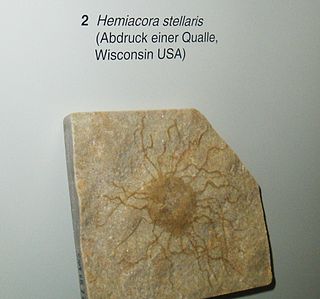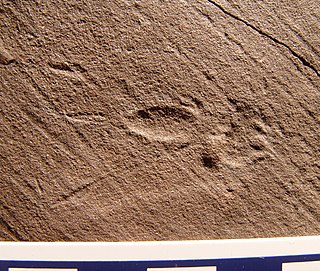
The Cambrian Period was the first geological period of the Paleozoic Era, and of the Phanerozoic Eon. The Cambrian lasted 53.4 million years from the end of the preceding Ediacaran Period 538.8 million years ago (mya) to the beginning of the Ordovician Period 485.4 mya. Its subdivisions, and its base, are somewhat in flux. The period was established as "Cambrian series" by Adam Sedgwick, who named it after Cambria, the Latin name for 'Cymru' (Wales), where Britain's Cambrian rocks are best exposed. Sedgwick identified the layer as part of his task, along with Roderick Murchison, to subdivide the large "Transition Series", although the two geologists disagreed for a while on the appropriate categorization. The Cambrian is unique in its unusually high proportion of lagerstätte sedimentary deposits, sites of exceptional preservation where "soft" parts of organisms are preserved as well as their more resistant shells. As a result, our understanding of the Cambrian biology surpasses that of some later periods.

A trace fossil, also known as an ichnofossil, is a fossil record of biological activity but not the preserved remains of the plant or animal itself. Trace fossils contrast with body fossils, which are the fossilized remains of parts of organisms' bodies, usually altered by later chemical activity or mineralization. The study of such trace fossils is ichnology and is the work of ichnologists.

Treptichnus is the preserved burrow of an animal. As such, it is regarded as the earliest widespread complex trace fossil. Its earliest appearance, around 542 mya, which was contemporaneous with the last of the Ediacaran biota, is used to help define the dividing line, considered geologically at 541 mya, between the Ediacaran and Cambrian periods. It is last seen in the fossil record during the Cenomanian.

Jeholornis is a genus of avialans that lived between approximately 122 and 120 million years ago during the early Cretaceous Period in China. Fossil Jeholornis were first discovered in the Jiufotang Formation in Hebei Province, China and additional specimens have been found in the older Yixian Formation.

Hiemalora is a fossil of the Ediacaran biota, reaching around 3 cm in diameter, which superficially resembles a sea anemone. The genus has a sack-like body with faint radiating lines originally interpreted as tentacles, but discovery of a frond-like structure seemingly attached to some Heimalora has added weight to a competing interpretation: that it represents the holdfast of a larger organism. This interpretation would stand against its original classification in the medusoid Cnidaria; it would also consign a once-popular hypothesis placing Hiemalora in the chondrophores, on the basis of its tentacle structure, to the dustbin. Studies testing the feasibility of hypothesis investigated the possibilities that such fragile tentacles could be preserved, and concluded that it would be very improbable — especially as many Hiemalora bearing beds also contain such fossils as Cyclomedusa, but do not preserve the tentacles on these organisms.
The Kaili Formation is a stratigraphic formation which was deposited during the Lower and Middle Cambrian. The formation is approximately 200 metres (660 ft) thick and was named after the city Kaili in the Guizhou province of southwest China.

An ichnofacies is an assemblage of trace fossils that provides an indication of the conditions that their formative organisms inhabited.

The Wheeler Shale is a Cambrian (c. 507 Ma) fossil locality world-famous for prolific agnostid and Elrathia kingii trilobite remains and represents a Konzentrat-Lagerstätte. Varied soft bodied organisms are locally preserved, a fauna and preservation style normally associated with the more famous Burgess Shale. As such, the Wheeler Shale also represents a Konservat-Lagerstätten.
Gordia marina is a lower Cambrian ichnofossil, and is the most common trace fossil in the Kaili biota displaying "smooth, cylindrical or subcylindrical, non-branching, winding and irregularly curving burrows, commonly self-overcrossing". Probably made by a worm-like creature displaying fodinichnial behaviour. It takes the form of unlined, curving parallel-walled burrows that often end with a nub, probably created as the creature probed the over- or under-lying sediment. It resembles Helminthopsis and Haplotichnus.

Ophiomorpha is an ichnotaxon, usually interpreted as a burrow of an organism living in the near-shore environment. The burrow lining is more or less smooth on the inside, and densely to strongly mammalated or nodose on the outside, due to the packing of fecal pellets for support of the burrow. Branching is irregular but Y-shaped where present. It is often considered part of the Skolithos ichnofacies, where it has occurred since the early Permian, though it has also occurred in deep water settings since the Late Jurassic, such as well-oxygenated turbidites.

Helminthopsis is the ichnogenus of a type of trace fossil that is found preserved on the bedding planes of fine-grained sedimentary rocks. It is characterized by short, curvilinear, non-branching, parallel-sided, unlined traces on bedding surfaces. It is thought to represent the submarine feeding trails of an invertebrate organism that worked the surface of muddy substrates in search of food. Because Helminthopsis traces never cross over themselves, the ichnogenus is distinguished from similar traces assigned to the Gordia ichnogenus. The similar sounding, but now obsolete, ichnogenus Helminthoida refers to a somewhat similar trace characterized by regular, back-and-forth meanders, whereas Helminthopsis traces are irregular.

The Nama Group is a 125,000 square kilometres (48,000 sq mi) megaregional Vendian to Cambrian group of stratigraphic sequences deposited in the Nama foreland basin in central and southern Namibia. The Nama Basin is a peripheral foreland basin, and the Nama Group was deposited in two early basins, the Zaris and Witputs, to the north, while the South African Vanrhynsdorp Group was deposited in the southern third. The Nama Group is made of fluvial and shallow-water marine sediments, both siliciclastic and carbonate. La Tinta Group in Argentina is considered equivalent to Nama Group.

Bohaiornithidae is a group of early predatory enantiornitheans from the early Cretaceous Period of China. All known specimens come from the Jiufotang Formation and Yixian Formation, dating to the early Aptian age, 125–120 million years ago. Bohaiornithidae was first coined as a family of enantiornithean birds by Wang and colleagues in 2014. They defined it as the natural group formed by all descendants of the common ancestor of the type species, Bohaiornis guoi, and Shenqiornis mengi.
The Mesilla Valley Shale is a geologic formation in southern New Mexico, northern Chihuahua, and far west Texas. It preserves fossils dating back to the Albian age of the early Cretaceous period.
Navidad Formation is a marine Neogene sedimentary formation located in Central Chile. The formation is known for its diverse and abundant fossil record and is considered the reference unit for the marine Neogene in Chile. Originally described by Charles Darwin in 1846 the formation has attracted the attention of numerous prominent geologists and paleontologists since then. As a key formation Navidad has been subject to a series of differing interpretations and scientific disputes over time.

Cheliceratichnus, meaning trace of a chelicerate arthropod, is an ichnogenus erected for a body imprint discovered in the Lower Jurassic East Berlin Formation of Holyoke, Massachusetts. The specimen is now housed at the Springfield Science Museum, which is one of multiple museums on the Quadrangle. Considering that only a single specimen was found, the ichnogenus is monospecific, with the species name lockleyi honoring paleontologist and ichnologist Martin Lockley. In trace fossil classification schemes based on behavior, the body imprint is considered a cubichnion, or resting trace. Cheliceratichnus lockleyi exhibits the tagma characteristic of arthropods, with the trace divided into anterior, central, and posterior regions. Dalman and Lucas (2015) interpreted these regions as imprints of the chelicerae, prosoma, and opisthosoma, respectively, of a chelicerate arthropod. Additionally, imprints of the animal's legs and telson were identified. These authors noted that, in general, the pattern of the trace was similar to the body plan of the Solifugae, or camel spiders, but also noted that the presence of a telson imprint rules out that group because these animals lack telsons. Consequently, they attributed the trace to a solifuge-like arthropod without being more committal on what made it. In addition to the body imprint, the animal produced a trackway, called Acanthichnus cursorius, leading away from the body imprint, which demonstrates that the animal was alive at the time its body imprinted the sediment.

This timeline of eurypterid research is a chronologically ordered list of important fossil discoveries, controversies of interpretation, and taxonomic revisions of eurypterids, a group of extinct aquatic arthropods closely related to modern arachnids and horseshoe crabs that lived during the Paleozoic Era.
Paleontology or palaeontology is the study of prehistoric life forms on Earth through the examination of plant and animal fossils. This includes the study of body fossils, tracks (ichnites), burrows, cast-off parts, fossilised feces (coprolites), palynomorphs and chemical residues. Because humans have encountered fossils for millennia, paleontology has a long history both before and after becoming formalized as a science. This article records significant discoveries and events related to paleontology that occurred or were published in the year 2021.













